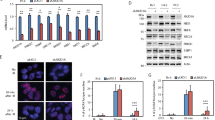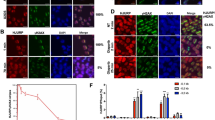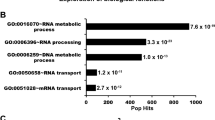Abstract
Histone H2A variant H2AX is a dose-dependent suppressor of oncogenic chromosome translocations. H2AX participates in DNA double-strand break repair, but its role in other DNA repair pathways is not known. In this study, role of H2AX in cellular response to alkylation DNA damage was investigated. Cellular sensitivity to two monofunctional alkylating agents (methyl methane sulfonate and N-methyl-N′-nitro-N-nitrosoguanidine (MNNG)) was dependent on H2AX dosage, and H2AX null cells were more sensitive than heterozygous cells. In contrast to wild-type cells, H2AX-deficient cells displayed extensive apoptotic death due to a lack of cell-cycle arrest at G2/M phase. Lack of G2/M checkpoint in H2AX null cells correlated well with increased mitotic irregularities involving anaphase bridges and gross chromosomal instability. Observation of elevated poly(ADP) ribose polymerase 1 (PARP-1) cleavage suggests that MNNG-induced apoptosis occurs by PARP-1-dependent manner in H2AX-deficient cells. Consistent with this, increased activities of PARP and poly(ADP) ribose (PAR) polymer synthesis were detected in both H2AX heterozygous and null cells. Further, we demonstrate that the increased PAR synthesis and apoptotic death induced by MNNG in H2AX-deficient cells are due to impaired activation of mitogen-activated protein kinase pathway. Collectively, our novel study demonstrates that H2AX, similar to PARP-1, confers cellular protection against alkylation-induced DNA damage. Therefore, targeting either PARP-1 or histone H2AX may provide an effective way of maximizing the chemotherapeutic value of alkylating agents for cancer treatment.
This is a preview of subscription content, access via your institution
Access options
Subscribe to this journal
Receive 50 print issues and online access
$259.00 per year
only $5.18 per issue
Buy this article
- Purchase on Springer Link
- Instant access to full article PDF
Prices may be subject to local taxes which are calculated during checkout







Similar content being viewed by others
References
Aebi S, Fink D, Gordon R, Kim HK, Zheng H, Fink JL et al. (1997). Resistance to cytotoxic drugs in DNA mismatch repair-deficient cells. Clin Cancer Res 3: 1763–1767.
Balajee AS, Geard CR . (2001). Chromatin-bound PCNA complex formation triggered by DNA damage occurs independent of the ATM gene product in human cells. Nucleic Acids Res 29: 1341–1351.
Balajee AS, Geard CR . (2004). Replication protein A and gamma-H2AX foci assembly is triggered by cellular response to DNA double-strand breaks. Exp Cell Res 300: 320–334.
Bassing CH, Chua KF, Sekiguchi J, Suh H, Whitlow SR, Fleming JC et al. (2002). Increased ionizing radiation sensitivity and genomic instability in the absence of histone H2AX. Proc Natl Acad Sci USA 99: 8173–8178.
Bassing CH, Suh H, Ferguson DO, Chua KF, Manis J, Eckersdorff M et al. (2003). Histone H2AX: a dosage-dependent suppressor of oncogenic translocations and tumors. Cell 114: 359–370.
Beardsley DI, Kim WJ, Brown KD . (2005). N-methyl-N′-nitro-N-nitrosoguanidine activates cell-cycle arrest through distinct mechanisms activated in a dose-dependent manner. Mol Pharmacol 68: 1049–1060.
Beranek DT . (1990). Distribution of methyl and ethyl adducts following alkylation with monofunctional alkylating agents. Mutat Res 231: 11–30.
Bouchard VJ, Rouleau M, Poirier GG . (2003). PARP-1, a determinant of cell survival in response to DNA damage. Exp Hematol 31: 446–454.
Celeste A, Difilippantonio S, Difilippantonio MJ, Fernandez-Capetillo O, Pilch DR, Sedelnikova OA et al. (2003a). H2AX haploinsufficiency modifies genomic stability and tumor susceptibility. Cell 114: 371–383.
Celeste A, Fernandez-Capetillo O, Kruhlak MJ, Pilch DR, Staudt DW, Lee A et al. (2003b). Histone H2AX phosphorylation is dispensable for the initial recognition of DNA breaks. Nat Cell Biol 5: 675–679.
Celeste A, Petersen S, Romanienko PJ, Fernandez-Capetillo O, Chen HT, Sedelnikova OA et al. (2002). Genomic instability in mice lacking histone H2AX. Science 296: 922–927.
Chou YH, Ho YS, Wu CC, Chai CY, Chen SC, Lee CH et al. (2007). Tubulozole-induced G2/M cell cycle arrest in human colon cancer cells through formation of microtubule polymerization mediated by ERK1/2 and Chk1 kinase activation. Food Chem Toxicol 45: 1356–1367.
Cohen-Armon M, Visochek L, Rozensal D, Kalal A, Geistrikh I, Klein R et al. (2007). DNA-independent PARP-1 activation by phosphorylated ERK2 increases Elk1 activity: a link to histone acetylation. Mol Cell 25: 297–308.
d'Adda di Fagagna F, Reaper PM, Clay-Farrace L, Fiegler H, Carr P, Von Zglinicki T et al. (2003). A DNA damage checkpoint response in telomere-initiated senescence. Nature 426: 194–198.
Downs JA, Lowndes NF, Jackson SP . (2000). A role for Saccharomyces cerevisiae histone H2A in DNA repair. Nature 408: 1001–1004.
Ethier C, Labelle Y, Poirier GG . (2007). PARP-1-induced cell death through inhibition of the MEK/ERK pathway in MNNG-treated HeLa cells. Apoptosis 12: 2037–2049.
Fernandez-Capetillo O, Chen HT, Celeste A, Ward I, Romanienko PJ, Morales JC et al. (2002). DNA damage-induced G2-M checkpoint activation by histone H2AX and 53BP1. Nat Cell Biol 4: 993–997.
Fernandez-Capetillo O, Lee A, Nussenzweig M, Nussenzweig A . (2004). H2AX: the histone guardian of the genome. DNA Repair (Amst) 3: 959–967.
Furuta T, Takemura H, Liao ZY, Aune GJ, Redon C, Sedelnikova OA et al. (2003). Phosphorylation of histone H2AX and activation of Mre11, Rad50, and Nbs1 in response to replication-dependent DNA double-strand breaks induced by mammalian DNA topoisomerase I cleavage complexes. J Biol Chem 278: 20303–20312.
Hoeijmakers JH . (2001). Genome maintenance mechanisms for preventing cancer. Nature 411: 366–374.
Horton JK, Stefanick DF, Naron JM, Kedar PS, Wilson SH . (2005). Poly(ADP-ribose) polymerase activity prevents signaling pathways for cell cycle arrest after DNA methylating agent exposure. J Biol Chem 280: 15773–15785.
Hurley LH . (2002). DNA and its associated processes as targets for cancer therapy. Nat Rev Cancer 2: 188–200.
Ichijima Y, Sakasai R, Okita N, Asahina K, Mizutani S, Teraoka H . (2005). Phosphorylation of histone H2AX at M phase in human cells without DNA damage response. Biochem Biophys Res Commun 336: 807–812.
Karran P, Offman J, Bignami M . (2003). Human mismatch repair, drug-induced DNA damage, and secondary cancer. Biochimie 85: 1149–1160.
Kauppinen TM, Chan WY, Suh SW, Wiggins AK, Huang EJ, Swanson RA . (2006). Direct phosphorylation and regulation of poly(ADP-ribose) polymerase-1 by extracellular signal-regulated kinases 1/2. Proc Natl Acad Sci USA 103: 7136–7141.
Lomax ME, Cunniffe S, O′Neill P . (2004). Efficiency of repair of an abasic site within DNA clustered damage sites by mammalian cell nuclear extracts. Biochemistry 43: 11017–11026.
McManus KJ, Hendzel MJ . (2005). ATM-dependent DNA damage-independent mitotic phosphorylation of H2AX in normally growing mammalian cells. Mol Biol Cell 16: 5013–5025.
Mischo HE, Hemmerich P, Grosse F, Zhang S . (2005). Actinomycin D induces histone gamma-H2AX foci and complex formation of gamma-H2AX with Ku70 and nuclear DNA helicase II. J Biol Chem 280: 9586–9594.
Mitra S, Kaina B . (1993). Regulation of repair of alkylation damage in mammalian genomes. Prog Nucleic Acid Res Mol Biol 44: 109–142.
Ochs K, Sobol RW, Wilson SH, Kaina B . (1999). Cells deficient in DNA polymerase beta are hypersensitive to alkylating agent-induced apoptosis and chromosomal breakage. Cancer Res 59: 1544–1551.
Redon C, Pilch DR, Rogakou EP, Orr AH, Lowndes NF, Bonner WM . (2003). Yeast histone 2A serine 129 is essential for the efficient repair of checkpoint-blind DNA damage. EMBO Rep 4: 678–684.
Rogakou EP, Boon C, Redon C, Bonner WM . (1999). Megabase chromatin domains involved in DNA double-strand breaks in vivo. J Cell Biol 146: 905–916.
Rogakou EP, Nieves-Neira W, Boon C, Pommier Y, Bonner WM . (2000). Initiation of DNA fragmentation during apoptosis induces phosphorylation of H2AX histone at serine 139. J Biol Chem 275: 9390–9395.
Rogakou EP, Pilch DR, Orr AH, Ivanova VS, Bonner WM . (1998). DNA double-stranded breaks induce histone H2AX phosphorylation on serine 139. J Biol Chem 273: 5858–5868.
Soldani C, Scovassi AI . (2002). Poly(ADP-ribose) polymerase-1 cleavage during apoptosis: an update. Apoptosis 7: 321–328.
Stiff T, O'Driscoll M, Rief N, Iwabuchi K, Lobrich M, Jeggo PA . (2004). ATM and DNA-PK function redundantly to phosphorylate H2AX after exposure to ionizing radiation. Cancer Res 64: 2390–2396.
Takai H, Smogorzewska A, de Lange T . (2003). DNA damage foci at dysfunctional telomeres. Curr Biol 13: 1549–1556.
Tibbles LA, Woodgett JR . (1999). The stress-activated protein kinase pathways. Cell Mol Life Sci 55: 1230–1254.
Wang H, Wang M, Bocker W, Iliakis G . (2005). Complex H2AX phosphorylation patterns by multiple kinases including ATM and DNA-PK in human cells exposed to ionizing radiation and treated with kinase inhibitors. J Cell Physiol 202: 492–502.
Ward IM, Chen J . (2001). Histone H2AX is phosphorylated in an ATR-dependent manner in response to replicational stress. J Biol Chem 276: 47759–47762.
Xu B, Kim ST, Lim DS, Kastan MB . (2002). Two molecularly distinct G(2)/M checkpoints are induced by ionizing irradiation. Mol Cell Biol 22: 1049–1059.
Yan Y, Black CP, Cowan KH . (2007). Irradiation-induced G2/M checkpoint response requires ERK1/2 activation. Oncogene 26: 4689–4698.
Acknowledgements
We acknowledge the generous gift of mouse ES cells proficient and deficient in H2AX from Dr CH Bassing and Dr FW Alt at the Department of Genetics, The CBR Institute for Biomedical Research, The Children's Hospital, Harvard Medical School, Boston, MA, USA. This study was partially supported by a research grant from US Department of Energy, Office of Sciences (BER) awarded to ASB (DE-FG02-05ER64055) and CRG (DE-FG 02-05ER 64054). ASB and CRG acknowledge the financial support received from NIH/NCI (5P01CA49062-16).
Author information
Authors and Affiliations
Corresponding author
Additional information
Supplementary Information accompanies the paper on the Oncogene website (http://www.nature.com/onc)
Supplementary information
Rights and permissions
About this article
Cite this article
Meador, J., Zhao, M., Su, Y. et al. Histone H2AX is a critical factor for cellular protection against DNA alkylating agents. Oncogene 27, 5662–5671 (2008). https://doi.org/10.1038/onc.2008.187
Received:
Revised:
Accepted:
Published:
Issue Date:
DOI: https://doi.org/10.1038/onc.2008.187
Keywords
This article is cited by
-
Mechanical stress confers nuclear and functional changes in derived leukemia cells from persistent confined migration
Cellular and Molecular Life Sciences (2023)
-
Interface of DNA Repair and Metabolism
Current Tissue Microenvironment Reports (2020)
-
AIF promotes chromatinolysis and caspase-independent programmed necrosis by interacting with histone H2AX
The EMBO Journal (2010)
-
MLH1 mediates PARP-dependent cell death in response to the methylating agent N-methyl-N-nitrosourea
British Journal of Cancer (2009)



